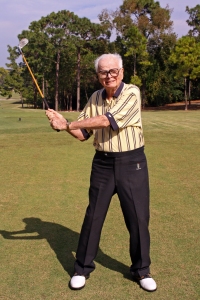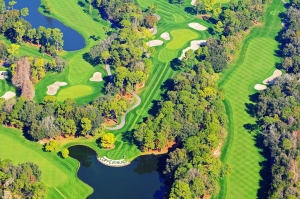by Beth Herman
 He’s 100 years old, sitting in the late afternoon sun inside his tidy residence at Palm Harbor, Florida’s famed Innisbrook Golf & Spa Resort.* A library of books by David McCullough, Henry Kissinger, et al, articulate the politics and passions of a seeker. In a moment, a clock chimes and a newly-acquired cat sidles in and out, perching a few inches from his owner who’s wearing a crisp Donald Ross plaid jacket. Though temperatures on a late March day hover around 80, doors and windows are closed up tight and a blanket stands at the ready.
He’s 100 years old, sitting in the late afternoon sun inside his tidy residence at Palm Harbor, Florida’s famed Innisbrook Golf & Spa Resort.* A library of books by David McCullough, Henry Kissinger, et al, articulate the politics and passions of a seeker. In a moment, a clock chimes and a newly-acquired cat sidles in and out, perching a few inches from his owner who’s wearing a crisp Donald Ross plaid jacket. Though temperatures on a late March day hover around 80, doors and windows are closed up tight and a blanket stands at the ready.
“I’ve been to where Donald Ross was born (Dornoch, Scotland),” says E. Lawrence (Larry) Packard when complimented on his clothing, speaking of the iconic pro golfer, golf course architect and sportswear designer who died in 1948. Ross, a founding member and first president of the American Society of Golf Course Architects (ASGCA), of which Packard was president from 1970-71, helped set the tone for an entity in which Packard is credited with transforming it from a social to professional organization. Packard also upped the ante on its conservation agenda. In fact over the past 60 years, Packard himself has designed or revitalized no fewer than 500 golf courses (some reports put it at 600) from Green Bay to Guatemala, including Innisbrook.

A river runs through it
He even made his own electricity to pump water from the Nile into Cairo’s Dreamland Pyramids Country Club – one of five Packard projects in that nation.
“You know,” Packard says, leaning in, “speaking of water, you need to have an 8-inch main – that’s as big as many small towns have – on every single fairway.”
As an early proponent of green building measures such as effluent irrigation, Packard practiced relocating trees cleared to create new courses to temporary nurseries and then strategically back to the original properties when

Arnold Palmer is in the house!
possible. Cited by contemporaries past and present, including Arnold Palmer, Jack Nicklaus and former partner Brent Wadsworth as modest, steady, gentle and caring, his respect for all living things also translated to the land.
Where his private life was concerned, though he didn’t take up golf until well into his 30s, Packard maintains he often relegated the game to the back burner because it took time away from his wife and children. “What were they going to do for the four or five hours I had to be gone? Sit around and look at each other?!” he quips.
In the details
Renowned for his signature courses on which every club in the bag should be used, and the occasional course twist and turn like a favored double dogleg, Packard came to the craft circuitously. As a young landscape architect he was hired to plant 1,500 acres of grass and design 2-mile-long camouflaged airstrips at Westover AFB in Massachusetts. It was World War II and according to one record, his work was so meticulous some of the veteran fighter pilots couldn’t even find the runways.

More tees please
Once penning a paper aligning golf course design with the tenets of Christianity, Packard admittedly started his life closer to pitch forks than putters. Born and raised in rural western Massachusetts, his father – a teetotaling high school graduate who reportedly cussed his way out of several jobs and towns – and his polar opposite mother, who’d attended two years of Smith College, were determined that he get through college. Packard flunked out of UMass Amherst once for not applying himself and had to wait a year to re-enroll, biding his time planting potatoes and later changing his major from science to landscape architecture because he loved to draw. His art defines the living and dining room walls of his Innisbrook residence, along with an early 1930s photograph of a strapping, square-jawed, determined young man whose transparent eyes give the observer a view within.

A young Larry Packard surveys the scene
After college, a first job with the U.S. Department of the Interior took Packard to Bar Harbor-adjacent Mount Desert Island in Maine, followed by a stint working on landscaping projects for E.A. McIlhenny’s Tabasco Sauce empire in Florida. He also contributed to the landscape and subsequent runway design of the then-unnamed O’Hare International Airport, recalling the challenge of removing traversing railroad tracks.

Copperhead fairways
In 1946, Packard cut his greens teeth with renowned golf course architect and mentor Robert Bruce Harris, finding his metier and never looking back. Estimating he put 30,000 miles per year on his car when commissioned for projects in the U.S. alone, his global gifts to golf include multiple courses in South Korea, Venezuela, Costa Rica, Egypt and more. In the U.S., possibly lauded most for his design of Illinois’ Eagle Ridge Inn & Resort and contribution of four courses – including the legendary Copperhead – to Florida’s Innisbrook, Packard saw a “natural roll and variety of the land and trees” at Innisbrook that set it apart from more conventional regional courses. “It feels more like the Carolinas,” he says. Noted by both amateurs and pros for its challenges, and supporting an annual PGA Tour, Packard said there are inherent rewards in playing Copperhead because golf, like life, should be fun.
The best laid plans
Speaking to his philosophy on golf course design, each course (ad)venture began by interviewing the relative superintendent, to whom Packard affirms he listened intently. Determining the site’s personality, and the flexibility to adapt to it, were also key components of his designs, along with prudent stewardship of natural resources.
In South Korea, a course for the Bomun Lake Golf Resort near Pusan, 150 miles south of Seoul, presented a unique set of challenges, conservation and otherwise. Using flat land to cultivate rice, what remains in Korea is hilly, even rugged terrain. According to Packard biographer Mickey Rathburn, though the site was visually stunning where views of mountains and the ocean prevailed, “…the land his Korean employer had staked out was not a place he could imagine accommodating level trees and chipped green fairways.” Rarely deterred, among other devices Packard sited the clubhouse atop some of the steep topography where golfers could enjoy unparalleled 360-degree views of the surrounding mountains.
Design for Bomun also involved removing some of the mountaintops and moving four times the amount of dirt to which Packard was accustomed, not to mention uprooting trees. To compensate, and where others may not have, Packard designed and executed an extensive planting scheme for the course.
Later welcoming son Roger into his practice, who has since moved to the more lucrative Shanghai, China in the wake of a waning U.S. economy for golf course architects, Packard claims he keeps himself going having eliminated most sugar, salt and fats from his diet.
“I had 60 years of loving my work – every day,” the centenarian says in response to a question about the secret to longevity.
“I traveled. I met new people. I loved doing what I did because I gave others a plan they could build on. Just do something you love in life, and never drink cheap booze.”

*Innisbrook is a Salamander Golf and Spa Resort
A special acknowledgment to Ramona Hurley, Media Relations
